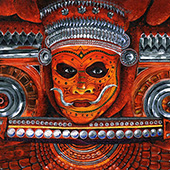The process and flow
• Theyyam preparation requires fasting for three, five, or seven days. The performer must remain at home and is not allowed to consume any non-vegetarian food during this time.
• Next is Theyyam ceremony's opening ritual. Setting a date and transferring the privilege to wear the Kolam. For doing this, they give the person who would wear the Kolam Kolakkaran, betel leaf, areca nut and money and entrust him with the Kolam's ritual name.
• The musicians and Theyyam performers arrive at the location one day beforehand. The ceremonies begin with the beating of the drum just before dusk falls.
• After the ornamentation and all, Theyyam has a custom of looking in the mirror. There are various degrees of significance in this. The Kolakkaran (the person who performs) internalizes the idea that he and god are inseparable when he sees god's image in the mirror. This aids in his possession.
• The Theyyam performance begins with Vellattam or Thottam. It is performed with only a small red headdress and no proper makeup or any decorative costume is used during this occasion.
• The musicians recite a specific ritual song that tells the stories and traditions of how the deity of the shrine came to be worshipped while being accompanied by drummers. At this time, traditional musical instruments are also accompanied.
• The dancer completes the main ritualistic portion of the chant before heading back to the green room.
• After a brief break, the dancer enters the temple ritualistically wearing elaborate costumes and makeup. He then takes a seat in front of the shrine, dons the headdress, the most sacred component of the outfit, and gradually changes into the specific deity of the shrine.
• The Theyyam dances, and performs around the temple and its courtyard. Last but not least, the dancer blesses the crowd by doling out turmeric powder and rice. He is regarded as divine as long as the headpiece is on.

